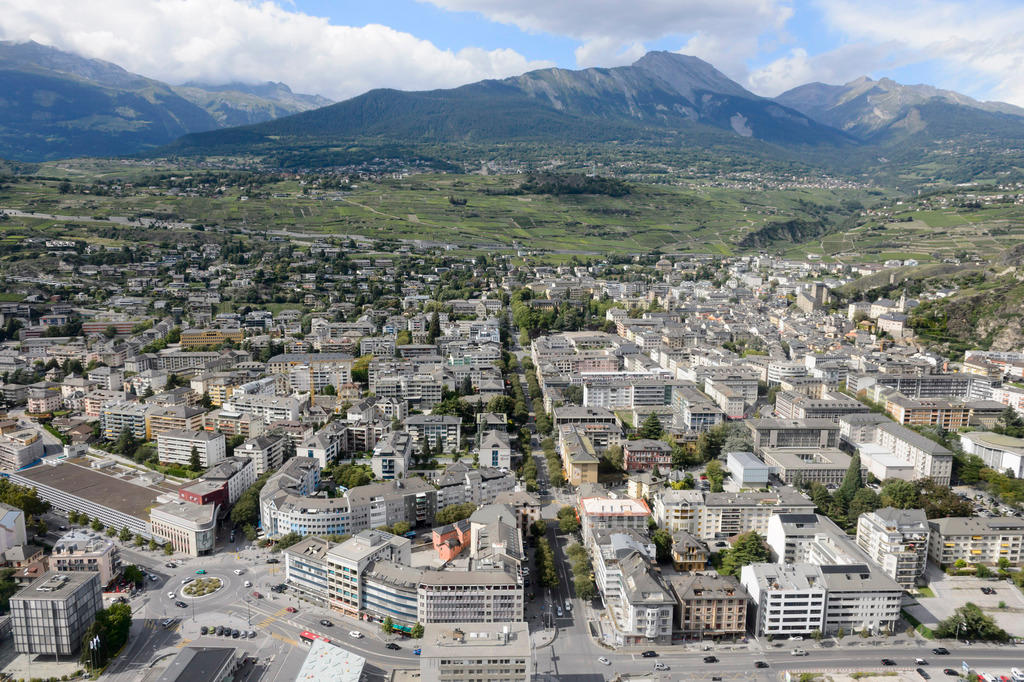
More grass and trees can help with ‘heat islands’ in Swiss cities

As temperatures continue to break records and shade-free parts of cities become increasingly unpleasant during searing summers, scientists in Zurich have developed a simulation program that can predict which pavement and which type of vegetation could help.
Münsterhof is the largest square in Zurich’s old town. Located in front of the Fraumünster church, the square is covered by cobblestones and concrete. There are some cafés and seats but no trees that would provide shade. What’s more, it is surrounded on almost all sides by buildings which absorb the heat of the sun.
City residents – that is, half the world’s population – know the feeling well: in summer, city centres turn into ovens. These are so-called urban heat islandsExternal link, a phenomenon linked to the density of asphalt surfaces and buildings and to the heat generated by vehicles, industry and heating systems or air conditioning.
Last summer Bernese artist Heinrich Gartentor covered Münsterhof with a meadowExternal link. Two shady willows from the Rapperswil Tree Museum were also installed.

More
July heatwave adds to one of hottest Swiss summers on record
During the project’s four-week run, many people asked the city authorities whether the meadow could remain permanently.
Aytaç Kubilay works in the Laboratory of Multiscale Studies in Building PhysicsExternal link at the Swiss Federal Laboratories for Materials Science and Technology (Empa) and at the Chair of Building PhysicsExternal link at ETH Zurich.
Kubilay and his colleagues had nothing to do with Gartentor’s project, but they chose the site to carry out climate simulations that can also be applied to other places and cities.
Their calculations show that the temperatures on the Münsterhof would be significantly lower if the square were not paved but covered with earth and grass. The ground would cool more during the night and store less heat during the day, Empa said in a press releaseExternal link.
Porous bricks
To find out how the assumed change would affect people, Empa researchers use the Universal Thermal Climate Index (UTCI). This measures the temperature as perceived by passers-by and takes into account not only air temperature but also humidity, surrounding surface temperatures, solar radiation and wind speed.
The result was that even if only a quarter of the paved area at Münsterhof were replaced by a different floor covering, “the oven would be turned off in summer”.
One possibility would be a pavement made of porous bricks, which could be watered and provide evaporative cooling,” the researchers said. A grassy landscape would also help – even if it were not permanently watered and sometimes dried out.
The times of day at which the Münsterhof UTCI index climbs above 32 (“severe heat stress”) would be significantly shorter with alternative floor covering, they said.
Role of trees
The result would be even clearer if trees were planted on Münsterhof.
Kubilay and his colleague Lento Manickathan simulated with their software the effect of four narrow standing trees on the northeast side of the square.
“The shade of the trees and at the same time their transpiration cooling would greatly reduce the heat stress,” Kubilay said.
“The perceived temperature would drop by two degrees on large parts of the square. Where the building façades are in the shade, it can even be up to four degrees. The trees can help cool down the square but also change the wind-flow field.”
After the model calculations at Münsterhof, the scientists want to refine their simulation in order to enable city planners to make detailed predictions on how climate change can be tackled.

More
When a tree is worth more than air conditioning

In compliance with the JTI standards
More: SWI swissinfo.ch certified by the Journalism Trust Initiative
















![The four-metre-long painting "Sonntag der Bergbauern" [Sunday of the Mountain Farmers, 1923-24/26] had to be removed by a crane from the German Chancellery in Berlin for the exhibition in Bern.](https://www.swissinfo.ch/content/wp-content/uploads/sites/13/2025/12/01_Pressebild_KirchnerxKirchner.jpg?ver=a45b19f3)











You can find an overview of ongoing debates with our journalists here . Please join us!
If you want to start a conversation about a topic raised in this article or want to report factual errors, email us at english@swissinfo.ch.